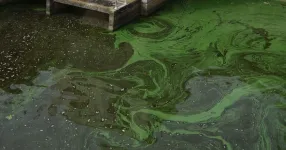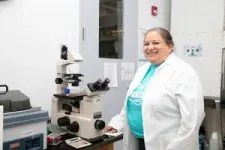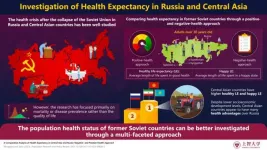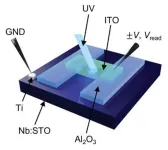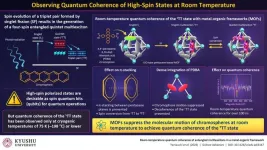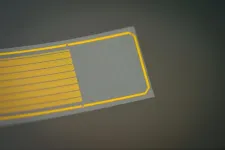Algal blooms produce a myriad of small organic molecules, many of which can be toxic to humans and animals. Among these phycotoxin producers is Microcystis aeruginosa, a freshwater cyanobacterium, which can be found in the Southern IRL. Measurable amounts of microcystins have been found in nasal swabs of people who live and work near the area, although finding microcystins in mucosal membranes may be evidence that the body is doing its job to eliminate them.
To help uncover potential human health hazards associated with harmful algae blooms in the IRL, researchers from Florida Atlantic University’s Harbor Branch Oceanographic Institute collected water samples from 20 sites within the lagoon during wet and dry seasons over a three-year period. The samples were extracted to concentrate organic molecules and these extracts were used in testing. To identify the presence of known or emerging toxins, researchers used a panel of immortalized human cell lines corresponding to the liver, kidney and brain to measure cytotoxicity. Human cell lines engineered to express ion transporters, red blood cells, and the activity against a protein phosphatase enzyme, also were used in the study. These cells and biological activities were selected as they are known to be affected by algal toxins and show unique patterns of activity for known toxins.
Samples were tested at high concentrations to detect as many metabolites as possible, and those that presented more than 50 percent cytotoxicity were considered active. Samples that exhibited high toxicity were further subjected to liquid chromatography-high resolution mass spectrometry analysis to assess the metabolites present in the sample.
Results of the study, published in the journal Toxins, show that each control toxin induced a consistent pattern of cytotoxicity in the panel of human cell lines assayed. During blooms, cytotoxicity due to a single type of toxin was obvious from this pattern. In the absence of blooms, the observed cytotoxicity reflected either a mixture of toxins or it was caused by an unidentified toxin.
“The most interesting observation from our study is that with the cell lines used, we could follow the patterns of known toxins,” said Esther Guzmán, Ph.D., corresponding author and a research professor at FAU Harbor Branch. “Known toxins were seen only during blooms. Because cell toxicity was seen in the absence of blooms, it suggests that there might be either emergent toxins or a combination of toxins present at those times. Our findings suggest that other toxins with the potential to be harmful to human health may be present in the lagoon.”
Among the study findings, the most northern sites of the lagoon exhibited less toxicity than sites to the south. Cytotoxic blooms were seen both in the south (Microcystis) and the north (Pyrodinium) of the lagoon. In the absence of blooms, South Fork, South Fork 2, North Fork and Middle Estuary (sites one to four) in the Southern IRL and Banana River, and North Banana River (NASA) (sites 14 and 15) in the Northern IRL appeared to have the most cytotoxicity during the time of the assessment.
In contrast, Jensen, Fort Pierce Inlet, Harbor Branch Link Port Canal, Vero Beach Land/Ocean Biogeochemical Observatory, and Vero Beach Barber Bridge (sites six to 10) appeared healthier as there were few samples with cytotoxicity above 50 percent in these sites, although there was statistically significant variation in these sites.
“A major question we sought to answer in this study was whether there are unrecognized toxins or other signaling molecules associated with harmful algal blooms in the lagoon,” said Amy Wright, Ph.D., co-author and a research professor, FAU Harbor Branch. “The data collected to date suggest that this is indeed the case. Importantly, using an assay panel to assess the presence of toxic materials could allow for better monitoring of human health impacts, especially from emerging toxins within the system.”
The researchers note that microcystins are primarily a threat to human health in the lagoon during blooms, and because of the necessity of active transport, the toxin would need to be ingested or inhaled to present a threat to humans.
“Ingestion can be avoided by filtering water through activated charcoal,” said Guzmán. “Similarly, effects due to inhalation are effectively blocked by the mucus membrane, which traps toxins that are subsequently eliminated through coughing. However, pet and wildlife exposures can still occur.”
Study co-authors Tara A. Peterson, coordinator, cancer cell biology, FAU Harbor Branch; Priscilla Winder, Ph.D., a chemistry research associate, FAU Harbor Branch; Kirstie T. Francis, Ph.D., an FAU graduate and current postdoctoral fellow in molecular microbiology, Mote Marine Laboratory; Malcolm McFarland, Ph.D., an assistant research professor in phytoplankton ecology, FAU Harbor Branch; Jill C. Roberts, a chemical scientist, FAU Harbor Branch; and Jennifer Sandle, a chemical scientist, FAU Harbor Branch.
This research was funded by a discretionary grant to the Florida Center for Coastal and Human Health from the Harbor Branch Oceanographic Institute Foundation.
- FAU -
About Harbor Branch Oceanographic Institute:
Founded in 1971, Harbor Branch Oceanographic Institute at Florida Atlantic University is a research community of marine scientists, engineers, educators, and other professionals focused on Ocean Science for a Better World. The institute drives innovation in ocean engineering, at-sea operations, drug discovery and biotechnology from the oceans, coastal ecology and conservation, marine mammal research and conservation, aquaculture, ocean observing systems and marine education. For more information, visit www.fau.edu/hboi.
About Florida Atlantic University:
Florida Atlantic University, established in 1961, officially opened its doors in 1964 as the fifth public university in Florida. Today, the University serves more than 30,000 undergraduate and graduate students across six campuses located along the southeast Florida coast. In recent years, the University has doubled its research expenditures and outpaced its peers in student achievement rates. Through the coexistence of access and excellence, FAU embodies an innovative model where traditional achievement gaps vanish. FAU is designated a Hispanic-serving institution, ranked as a top public university by U.S. News & World Report and a High Research Activity institution by the Carnegie Foundation for the Advancement of Teaching. For more information, visit www.fau.edu.
END
